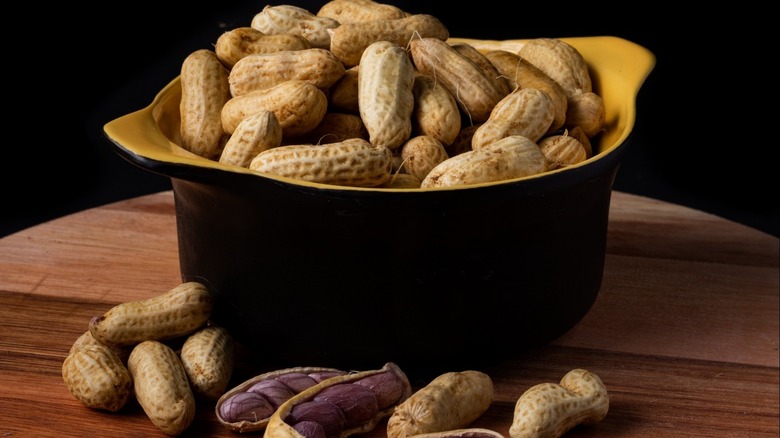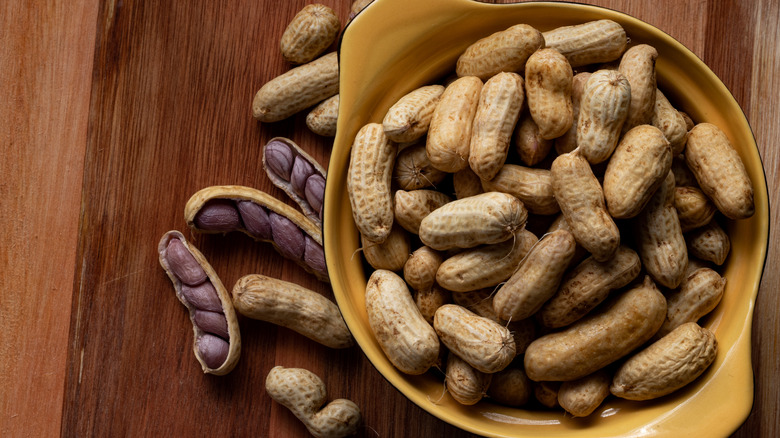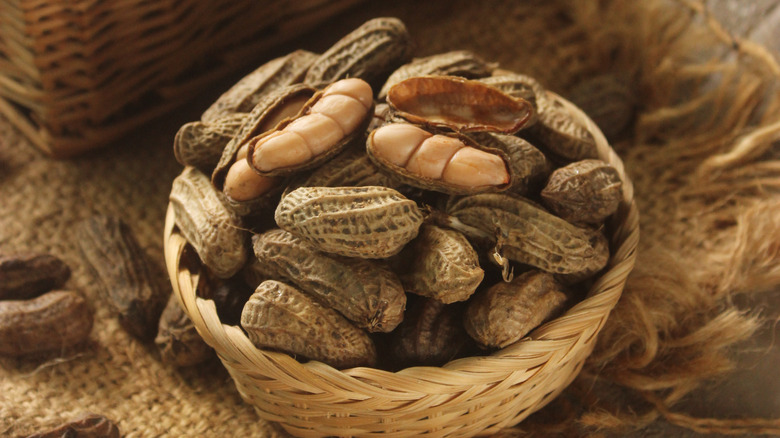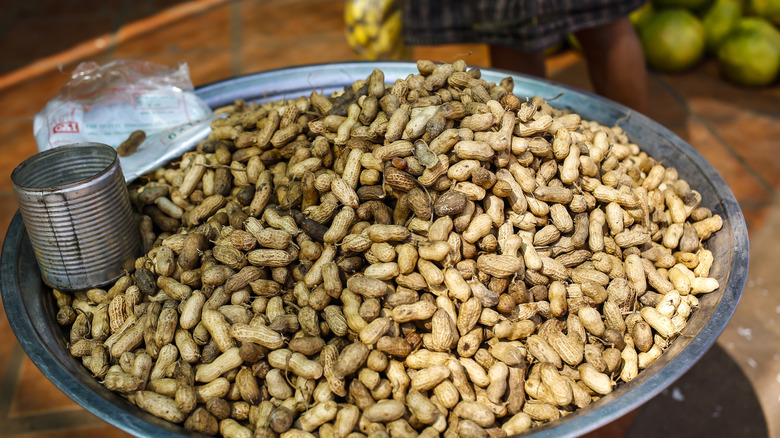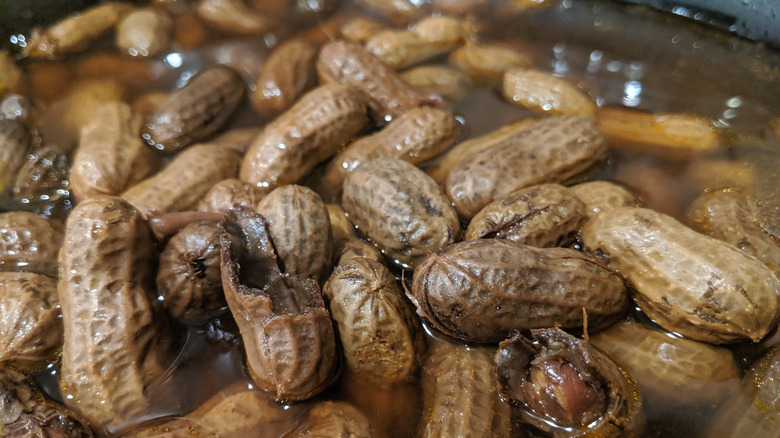What Are Boiled Peanuts, And How Do You Eat Them?
To those unfamiliar with this iconic Southern treat, boiled peanuts can seem like a peculiar snack. Why are they boiled? Do you eat the shell? Is the flavor different from "raw" peanuts? But don't fret; we'll answer all of those questions for you and more.
Boiled peanuts are a tried-and-true tradition in the southern United States that are often enjoyed as a roadside snack, according to Southern Living. Paste describes the food's texture as "very similar to edamame." While some aficionados do eat the shell, according to Paste, many simply use the covering as a vessel to facilitate a smooth eating process — similar to an oyster shell — and discard it from their mouth. Many people consume their boiled peanuts outdoors, where they can freely spit out or discard the shells into the grass. Also similar to an oyster, a boiled peanut is encased in brine — or salty liquid — that adds to the flavor and mouthfeel. Boiled peanuts are also a popular snack at sporting events and fairs, SCIWAY notes.
Nutritional information about boiled peanuts
Livestrong notes that not only are boiled peanuts a comforting snack standby, they're also nutritious — they're packed with fiber, minerals, protein, and numerous vitamins. These certain nutrients in the legumes can also provide benefits for pregnant people and those looking to lose weight, as well as be a great source of energy. Just make sure to eat boiled peanuts within three or four days, unless refrigerated or frozen, or else "they become slimy and smelly" (via What's Cooking America). Peanuts can of course also be roasted, but cooking the legumes in salted, boiling water can preserve them for as long as a week.
Peanuts are technically legumes and not nuts, Harvard Health Publishing clarifies. And, What's Cooking America notes, a green peanut is not actually green in color — in this case, the term "green" refers to its lack of maturation, as it is usually freshly picked.
A fascinating history
Our Mississippi Home notes that peanuts were first seen in a cookbook in 1847. Green peanuts "weren't ripe enough to roast," Paste reports, and Southern roadside and sidewalk vendors began selling boiled peanuts in the early 1920s. While during that time roasted peanuts became a popular snack food at events and in recipes in the North, according to Charleston City Paper, the boiled variety "seems to have been confined to just a limited part of the Carolinas."
Although some outlets such as What's Cooking America describe boiled peanuts as a beacon of ingenuity by Confederate soldiers during the Civil War, this searing piece in Serious Eats clearly disputes that. The publication reports that peanuts "came to the region by way of the African diaspora" and that African Americans in the pre-Revolutionary era grew them in their gardens. Boiled peanuts "spanned the whole range of Southern society, from the West African slaves who actually invented the dish to the white cooks who then ran with the idea as party food."
Charleston City Paper states that the peanut's travel to the American South was "via a circuitous route" — originating in South America, brought to Africa by the Portuguese around 1500, then coming to the South on slave ships in the 1700s. A captured Union soldier in the 1800s wrote that "some of the African-American residents" gave him boiled peanuts, which were a "favorite way of cooking when the bean was too green to bake."
Variations and uses for boiled peanuts
Raw and roasted peanuts are known for their brittle crunch, so boiling them and rendering them squishy might seem counterproductive. But the texture of the legumes after boiling can be different depending on personal taste. As HuffPost notes, boiled peanuts can be made "to mush if you like them like that, sometimes just on the border of crunchy and tender."
Paste notes that pureeing boiled peanuts transforms them into a form of hummus, and of course, a large bowl of boiled peanuts is a superb, convivial snack for a large group. Some also add more than salt to the boiling liquid — sometimes opting for additional seasoning to gussy up the familiar standby. Some popular variations are with Old Bay, beer, barbecue sauce, Cajun seasoning, or flavored salts, according to Southern Living and Paste.
HuffPost even notes that some deem boiled peanuts "the caviar of the South." Fun fact: The boiled peanut is even South Carolina's official state snack, according to the South Carolina Legislature. Clearly, boiled peanuts have become an iconic food and a cultural mainstay.
An iconic regional party food
So while the texture of boiled peanuts can seem a bit peculiar at first — Paste describes them as "soggy" — many people have relished the soft, salty snack for centuries. Taste-wise, Serious Eats states that boiled peanuts "bring forward [peanut's] essential pea-ness," while roasted peanuts are more inherently nutty. Although newbies can find them to be "a shock to the system," the beguiling salty flavor and soft textural components of boiled peanuts can be the two main draws for most boiled peanut fanatics — and the lore that comes with picking up a bag and mindlessly munching away whilst watching a game or strolling through a fair.
Interestingly enough, boiled peanuts suddenly became en vogue in the early 1900s, even becoming a "fashionable thing to serve at weddings and parties," according to Serious Eats. The publication also notes that the process of boiling peanuts is a natural fit for parties, as a large crowd can gather around a giant pot to shell, talk, laugh, and eat. Peanut boilings soon blossomed in popularity, spreading the charming snack food throughout the American South. Nowadays, many top chefs even incorporate the snack standby in gourmet dishes, as Serious Eats notes.
